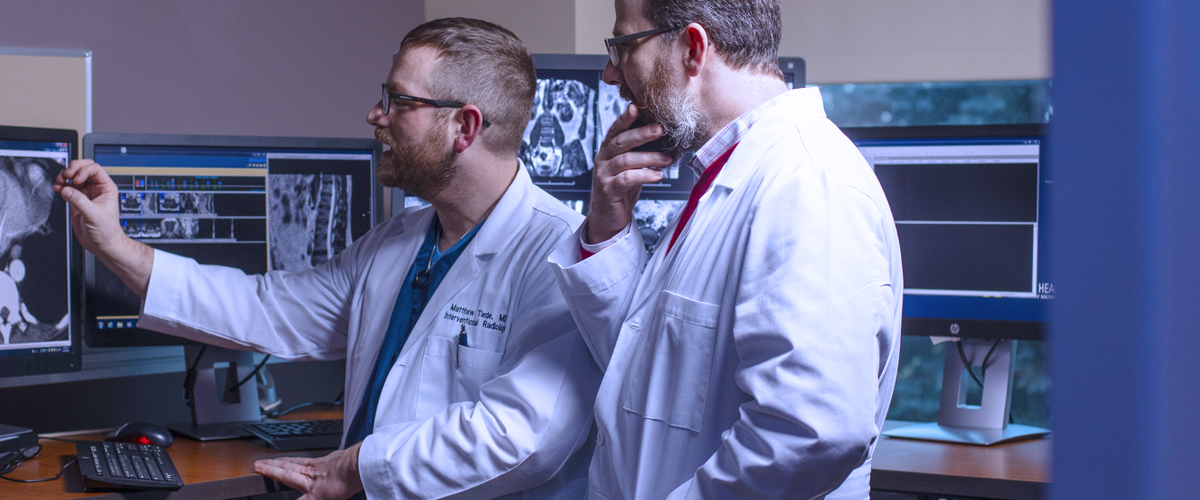Patient Shielding
At UM Health-West-University of Michigan Health, we have stopped using patient shielding and will no longer place lead aprons or gonad shields over you during your x-ray, CT, or Fluoroscopy exam.
Technological and procedural improvements have eliminated the need for the radiation protective apron. Additionally, many years of research have shown that radiation exposure used in modern diagnostic x-ray exams is less harmful than originally thought.
These studies have also shown that shielding patients carries the risk of using more radiation than not using shielding and could cover a body part that the doctor needs to see.
For patient safety, experts on x-rays agree that patient shields should not be used.
Frequently Asked Question’s
I thought lead protects me from the radiation. Why are you not using shielding anymore?
The shield may hide important organs or body parts that the doctor needs to see If this were to happen, we would have to take another x-ray, which would increase the total amount of radiation you receive.
For patient safety, the Food and Drug Administration (FDA) and other experts on x-rays agree that patient shields should not be used for routine x-ray exams.
Could radiation to the gonads increase my risk of infertility?
The amount of radiation required to cause infertility is more than 100 times the dose from a medical imaging exam.3
For example, the gonadal dose to an X-ray of the pelvis is less than 0.8 mGy for a teenage boy and less than 0.3 mGy for a teenage girl. Gonadal doses for newborns receiving medical imaging is about 90% lower than this.4 In comparison, male fertility is not affected below an acute dose of 150 mGy. Permanent sterility does not occur in males below 3500 mGy. Female fertility is not affected below 2500 mGy.3
Why have I been shielded in the past if there was no benefit?
Patient shielding was first recommended in 1976 by the FDA. At that time, patient shielding was thought to protect patients from hereditary risks. Now after more than 50 years of research, we know that is not true. In addition, modern x-ray machines use ~96% less radiation than the machines used, back when the recommendations to shield patients were made.
How does the equipment at UM Health-West ensure the lowest levels of radiation?
UM Health-West- University of Michigan Health only uses the latest x-ray digital imaging technology. This technology means the least amount of radiation is used to produce high quality Imaging exams for patients of all sizes.
Our technologists are also educated on low radiation imaging practices. Our imaging team also includes medical physicists that annually review patient radiation exposure and make sure that the radiation used for our x-ray exams is among as low as it can be, while still providing diagnostic images.
Will patient shields be eliminated for all imaging exams?
If a shield gets in the way of these sensors, the machine could deliver more radiation than necessary. The shield also has the potential to reduce the quality of theses exams. For these reasons, we will not shield patients during X-ray, Fluoroscopy, and CT exams.
Will you provide shielding for body parts outside of the imaging field?
The radiation exposure to the patient areas outside of the imaging field is extremely small. Shielding these areas provides negligible benefit. Since there is a possibility that the shield could move into field if the patient moves, we recommend not to do it. However, if requested, we will shield other body parts outside of the image field. We understand that a shield can be comforting and ease fear or anxiety about the x-ray exam.
References
- AAPM PP 32-A: AAPM Position Statement on the Use of Patient Gonadal and Fetal Shielding. (2019).
Retrieved from https://www.aapm.org/org/policies/details.asp?id=468&type=PP¤t=true - AAPM Patient Gonadal and Fetal Shielding in Diagnostic Imaging Frequently Asked Questions retrieved from https://www.aapm.org/CARES/
- ICRP, 2007. The 2007 Recommendations of the International Commission on Radiological Protection. ICRP Publication 103. Ann. ICRP 37 (2-4).
- Frantzen, M. J., Robben, S., Postma, A. A., Zoetelief, J., Wildberger, J. E., & Kemerink, G. J. (2012).Gonad shielding in in pediatric pelvic radiography: disadvantages prevail over benefit. Insights Imaging, 3, 23–32.
- Marsh, Rebecca M., and Michael Silosky. “Patient Shielding in Diagnostic Imaging: Discontinuing a Legacy Practice.” American Journal of Roentgenology, vol. 212, no. 4, 2019, pp. 755–757., doi:10.2214/ajr.18.20508.
News Articles
Chicago Tribune | “Some Hospitals Say Using Lead Aprons for X-rays Does More Harm Than Good”
New York Times | “That Lead Apron in the X-Ray Room? You May Not Need It”
StatNews | “Lead Aprons Offer Little Protection During X-rays. Why Do So Many Clinicians Keep Using Them?”
